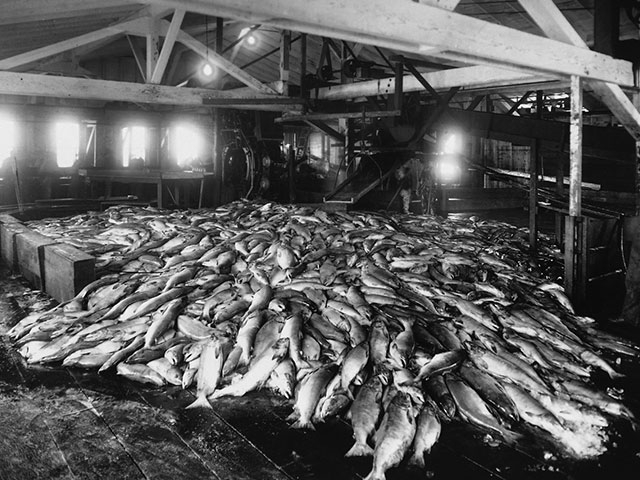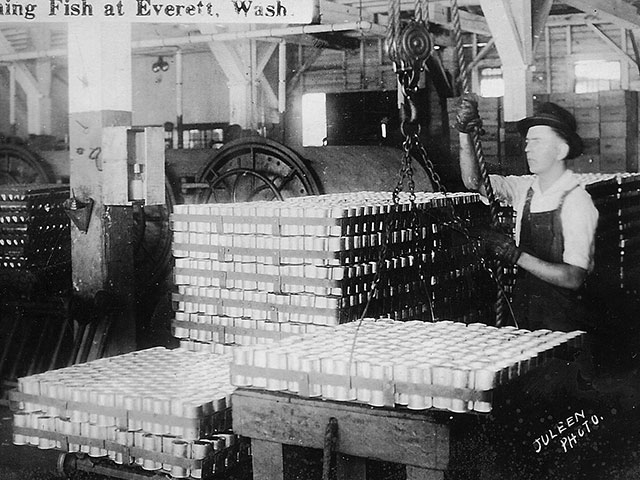1930 - 1939
Timeline
1930
Puget Sound Pulp and Timber Company is built at the foot of 26th Street, once the site of the Everett Flour Mill Company, beginning more than 80 years of pulp and paper production in Everett. But hard economic times during the Great Depression force the company to later sell to Soundview Paper Company, which continues into the 1950s under that name. The site later becomes Scott Paper Company, then the Kimberly-Clark mill.
1931
The Everett Yacht Club opens a new clubhouse on land leased from the Port. The two-story building sits on a bayside site just west of the Great Northern Railway Depot, near Pier 2/City Dock. A lighthouse tower (replete with a blue and white blinker light) anchors the club’s northeast corner.
1933
Local morale gets a boost when the USS Constitution (“Old Ironsides”), on a tour of Pacific Coast ports, visits Everett — docking at Pier 1 from July 7th to the 14th. The striking, wooden-hulled, three-masted heavy frigate is on a three-year tour around the country as a public “thank you” to everyone who, from 1925 to 1930, helped raise nearly $1 million to restore the deteriorating vessel, which was built in 1797. Nearly 56,000 people visit the frigate during its time in Everett. (The Constitution, the oldest commissioned ship in the United States Navy and a National Historic Landmark, is now harbored in Boston.)
1935
The Everett Yacht Club buys the Black Prince from the American Tug Boat Company for one dollar. The sternwheel steamer is placed on a permanent cradle next to the club’s building; in 1936 it becomes the Yacht Club’s official meeting room.
1937
An immense fire razes the shuttered Clough-Hartley Shingle Mill located at the foot of 18th Street on the bayfront. A 40-mile per hour gale wind reportedly whips flames through the structure; it takes firefighters several hours to control them. The building was mostly empty — the business closed in 1929 and its machinery had been removed. The flame’s sparks landed in a log basin between 14th and 18th streets.
1937
Local commercial fishermen, based near the Everett Yacht Club and the old City Dock (at the Port’s Tract M) at the time, propose that the Port build a net drying and storage shed. The Port agrees and sets them up with facilities at Tract O, at the foot of 21st Street.
1937
Pacific Coast members of the American Federation of Labor’s International Longshoremen's Association (ILA) form the International Longshoremen’s and Warehousemen’s Union (ILWU).
1938
After the bayfront Weyerhaeuser Mill A is converted to a pulp mill, the Gothic-style Weyerhaeuser Office Building is saved — and moved by barge to the company’s Mill B site on the Snohomish River on the north side of Everett. (The building will serve as office space until that mill closes in 1979.)
1938
The Fishermen’s Packing Corporation co-op, organized on the Everett waterfront in 1928, relocates north to Anacortes, Washington.
1938
The new Norton Avenue viaduct over the Great Northern Railway tracks at 22nd Street is built for $60,000, easing vehicle access to the waterfront.
1939
The Port Commission approves $190,000 in bonds for the enlargement of Tract O, the new commercial fishing moorage site.
Adjusting to the Great Depression
The Great Depression took its toll on the people and businesses along the Everett waterfront, along with the rest of the country. Some new businesses, such as the Puget Sound Pulp and Timber Company, joined the waterfront. Others, such as Weyerhaeuser Mill A, adjusted their operations. And some industries floundered; by 1937, Super Shingle (later named Super Mill Company) was the only remaining mill
on the 14th Street Dock. The Port of Everett saw opportunity though, and began acquiring property along the dock from private owners.
The 1930s brought an end to most of the “Mosquito Fleet” steamers, which became obsolete because of their outdated machinery, as well as the addition of new roads throughout the region. And the privately owned Black Ball Line offered diesel/electric-powered car and passenger ferries; they established regular routes, including one that docked at Mukilteo, where the Port owned a landing.
Interest in recreational boating grew steadily and the Everett Yacht Club responded, building a two-story clubhouse at the south waterfront in 1931 (today the site of the Port’s cement storage dome). The Yacht Club later tacked onto the structure the retired steamer the Black Prince, putting the dry-docked vessel into service as a distinctive meeting room and annex.
The commercial fishing industry was settled in nearby, too, west of the Great Northern Railway between Piers 1 and 2 at what was called “Tract M.” In the 1930s, reportedly more than 800 men earned their living at sea, trolling for the area’s rich catch, which included salmon, halibut, ling cod and crab. Around 100 purse seiners, tenders and scows operated for the Fishermen’s Packing Corporation co-op, which
had organized on the south bayfront in 1928 — though by the end of the 1930s the group had moved to Anacortes, Washington, to save on costs.
Discussions between the fishermen and the Port on how to improve their base at Tract M were ongoing throughout the decade, however. In 1932, fishing boat owners asked about improving their mooring facilities and adding storage. The Port’s facilities at Tract M were used by the purse seine fleet for winter storage, and boats were hauled up to dry and undergo repairs there as well. But the area was crowded,
so in 1937 fishermen lobbied for a net shed — a space for them to stash and work on their seine nets and other fishing gear. The Port agreed to provide some sheds, and in 1938 it did so when it moved the fishing operation north to “Tract O” bayside at the foot of 21st Street (now part of Naval Station Everett).
Dredging and filling projects ramped up throughout the decade as well; federal funding was used to remove silt from the basin south of the 14th Street Dock, creating a deep harbor. (That silt, as with many other dredging projects, was pumped over to Jetty Island.) The U.S. Army Corps of Engineers also helped with the removal of shoaling in the upper harbor. This material was used to fill in the area underneath and around the old wooden pilings of the Norton Avenue trestle, creating a smoother, more permanent waterfront thoroughfare. And in 1938, a new Norton Avenue viaduct over the Great Northern Railway tracks at 22nd Street was built, furthering improvement to the flow of waterfront traffic.
And finally, at the Seaport, in 1937 the International Longshoremen’s and Warehousemen’s Union (ILWU) was formed — a group that brought together a mix of former Industrial Workers of the World (IWW) and International Longshoremen’s Association (ILA) members. The ILWU primarily represents dock workers on the West Coast of the mainland United States, and in Hawaii, Alaska and British Columbia, Canada. Today, more than 14,200 ILWU workers are employed at West Coast ports, and Locals 32, 98 and 52 all serve the
Port of Everett, respectively as longshoremen, walking bosses/foremen, and marine clerks.




















